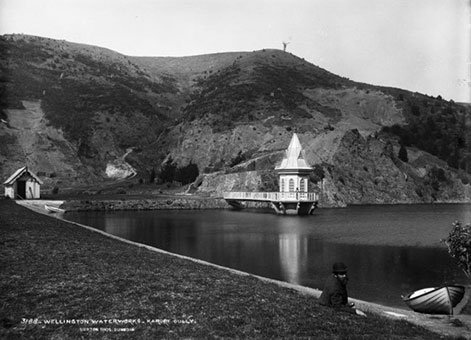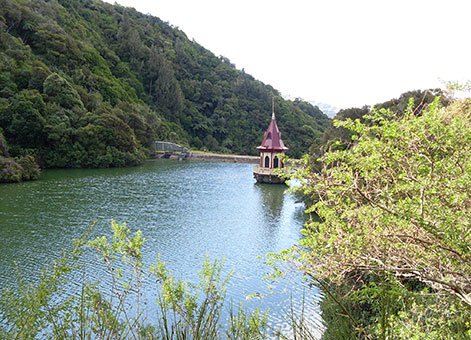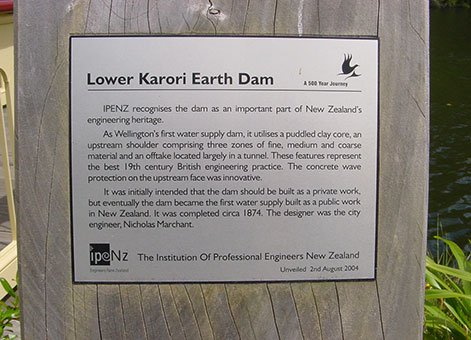The Karori Water Supply Dams and Reservoirs captured the water resources of the Kaiwharawhara Stream in the west Wellington hill suburb of Karori, and are now within the Karori Wildlife Sanctuary. The Lower and Upper Karori Dams were completed in 1878 and 1908 respectively, and continued to contribute to the New Zealand capital city’s water supply until the late 20th century.

Karori Reservoir, Wellington. Zoe Martin-Carter: Photographs of Wellington and the Centennial Exhibition. Ref: PA1-f-171-75. Alexander Turnbull Library, Wellington, New Zealand. /records/22670273
A good water supply is essential to human existence. The population of Wellington rose rapidly in the 1860s and 1870s, with residents and industry putting severe pressure on streams and wells. Public health was at risk and this motivated local government to investigate establishing a public waterworks system, with various proposals put forward. However, it was not until the passing of the Wellington Waterworks Act in 1871 that earnest planning could commence, and with the completion of the Lower Karori Dam in 1878 Wellington became the first municipality in New Zealand to construct a public water supply dam. From that time progressive development of the water resources at Karori, and around the Wellington region, struggled to keep up with demand. Another early addition to the water supply system was the Upper Karori Dam, constructed between 1906 and 1908.

Karori Reservoir, including valve tower, Wellington. Burton Bros. Ref: BB-3188-1/1-G. Alexander Turnbull Library, Wellington, New Zealand. /records/22749985

Dam under construction in the Karori Reservoir valley, Wellington. Ref: 1/1-019829-G. Alexander Turnbull Library, Wellington, New Zealand. /records/23012543
The Lower Karori dam was designed by Nicholas Marchant (1836–1907) and is an earth dam with a puddled clay core. Availability of materials meant that this structure was innovative in its use of concrete, rather than stone, for its wave protection lining and culverts. It was the use of concrete which also made the Upper Karori Dam a pioneering structure; it being one of the earliest New Zealand examples of a large scale concrete gravity dam. This structure was designed by another notable Wellington City Engineer, William Hobbard Morton (1866–1923).

Lower Karori Dam reservoir, Wellington, 2010. IPENZ.
The Karori Water Supply Dams and Reservoirs have outstanding engineering heritage value because the dams both represent early large scale examples of their respective dam types. Located on the Wellington fault, these dams were decommissioned in the 1990s due to earthquake safety concerns. However, for over a century the Karori waterworks was heart of the wider system in Wellington and, as a result, had considerable social impact.

Lower Karori Earth Dam.
Heritage recognition
Karori Water Supply Dams and Reservoirs was added to the IPENZ Engineering Heritage Register on 28 August 2012.
Read the heritage assessment. | 1012.5 KB
IPENZ recognised the engineering heritage importance of the Lower Karori Dam with a plaque unveiled in 2004.
Aspects of this place have been individually recognised by Heritage New Zealand as a Category 1 historic place (List no.7750) and a Category 2 historic place (List no.7749):
Lower Karori Dam: New Zealand Heritage List/Rarangi Korero information
Upper Karori Dam: New Zealand Heritage List/Rarangi Koreroinformation
More information
Location
Karori Wildlife Sanctuary/Zealandia, Waiapu Road, Karori, Wellington.
Access
The dam can be viewed during the opening hours of the Karori Wildlife Sanctuary.
References
P. Cook, Our water history – on tap: Water supply in the Wellington region 1867-2006, Wellington, 2007.
R. E. Offer, Walls for Water: Pioneer Dam Building in New Zealand, Wellington, 1997.

